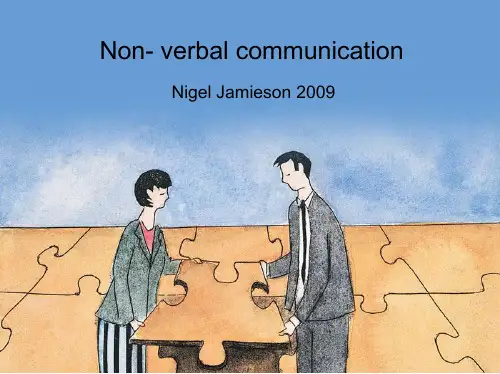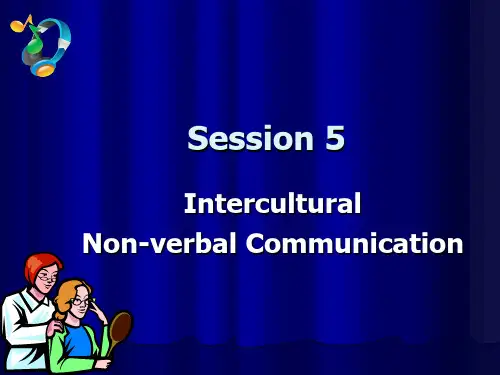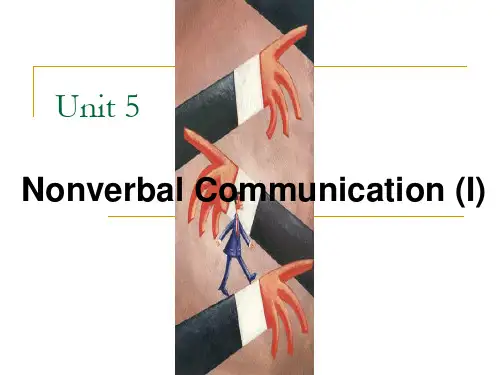NONVERBAL COMMUNICATIONOklahoma Panhandle State 非语言沟通奥克拉荷马州立
- 格式:ppt
- 大小:130.00 KB
- 文档页数:15
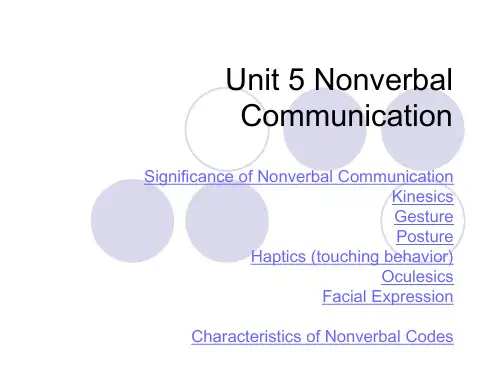
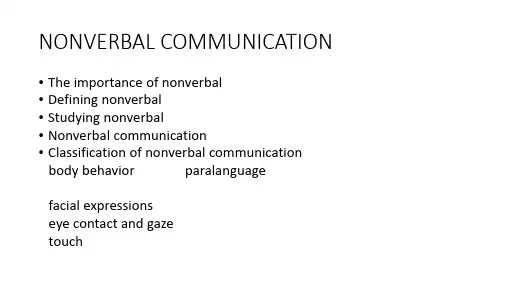

Unit 5Nonverbal CommunicationIBC COURSEWARE OF EDWARD ZHANGObectivesI. What is nonverbal communication II. Nonverbal communication and culture III. Functions of nonverbal communication IV. The Importance of Nonverbal Communication V. Nonverbal communication: guidelines andlimitations VI. Categories of Nonverbal CommunicationIBC COURSEWARE OF EDWARD ZHANGIBC COURSEWARE OF EDWARD ZHANGI. Defining nonverbal communication• 1. Nonverbal communication involves all nonverbal stimuli in a communication setting that are generated by both the source and his or her use of the environment and that have potential message value for the source or receiver.• 2. Nonverbal messages may be both intentional and unintentional.IBC COURSEWARE OF EDWARD ZHANGII. Nonverbal communication and culture • 1. Much of our nonverbal behavior, likeculture, tends to be elusive, spontaneous, and frequently beyond our awareness.IBC COURSEWARE OF EDWARD ZHANG• 2. Culture is all-pervasive, multidimensional, and boundless; it is everywhere and in everything. The same is true of nonverbal behavior.IBC COURSEWARE OF EDWARD ZHANG• 3. Another parallel between culture and nonverbal behavior is that both need to be learned.IBC COURSEWARE OF EDWARD ZHANG• 4. Studying nonverbal behavior can lead to the discovery of a culture's underlying attitudes and values. It can also assist us in isolating our own ethnocentrism.IBC COURSEWARE OF EDWARD ZHANGIII. Functions of nonverbal communication • To repeat, complement, substitute for averbal action, regulate, and contradict a communication event.IBC COURSEWARE OF EDWARD ZHANGIV. The importance of nonverbal communication• 1.We make important judgments and decisions about others based on their non-verbal behavior.• 2. We use the actions of others to learn about their affective or emotional states.• 3. Many of our nonverbal actions are not easily controlled consciously.• 4. Nonverbal communication is important to the study of intercultural communication because a great deal of nonverbal behavior speaks a universal language.IBC COURSEWARE OF EDWARD ZHANGV. Nonverbal communication: guidelines and limitations1.It is important to remember that we are all more than our culture.2. In nonverbal communication, we often make differences more important than they should be.3. Nonverbal actions seldom occur in isolation.IBC COURSEWARE OFVI. Categories of Nonverbal Communication•1. Those primarily produced by the body: appearance, movements (kinesics), facial expressions, eye contact, touch.•2. Those the individual combines with the setting: space, time, and silence.IBC COURSEWARE OF2. Body movement (kinesics)•posture•gesturesIBC COURSEWARE OF3. Facial Expressions4. Eye contact and gaze5. TouchIBC COURSEWARE OFIBC COURSEWARE OFhe/she is ready to move at any time. his/her feelings, trying to calm down.•How Body Communicates, from head to toesIBC COURSEWARE OFHEAD-Nodding the head-“Yes”in most societies-“No”in some parts of Greece, Yugoslavia, Bulgaria, and Turkey•Tossing the head backward–“yes”in Thailand, the Philippines, India, LaosIBC COURSEWARE OFFACE IBC COURSEWARE OFIBC COURSEWARE OFEYES*Eye contacts-Encouraged in America, Canada, Europe-Rude in most Asian countries and in Africa*Winking eye-Sharing secret in America and Europe-flirtatious gesture in other countries*Closed eyes-bored or sleepy in America-“I’m listening and concentrating.”in Japan, Thailand, ChinaIBC COURSEWARE OFEars*Ear grasp-“I’m sorry.”in parts of India*Cupping the ear-“I can’t hear you.”in all societies*Pulling ear-“You are in my heart”for Navajo IndiansIBC COURSEWARE OFIBC COURSEWARE OFLIPS AND MOUTHCheeks*Cheek screw-gesture of praise -Italy-“That’s crazy.”Germany*Cheek stroke-“pretty, attractive, success”most EuropeIBC COURSEWARE OFTHE LIP POINTING*Kiss. In parts of Asia, kissing is considered an intimate sexual act and not permissible in public, even as a social greeting.IBC COURSEWARE OFTHE LIP POINTING •Finger tip kiss. In France, it conveys several messages, “That’s good!”“That’s great!”“That’s beautiful!.”IBC COURSEWARE OFIBC COURSEWARE OFTHE LIP POINTING*Open mouth. Any display of the open mouth is considered very rude in mostcountries.Fingers*The “O.K.”signal. (the thumb and forefinger form a circle) means*“fine,”or “O.K.”in most cultures,*“zero”or “worthless”in some parts ofEurope*“money”in Japan*an insult in Greece, Brazil, Italy, Turkey,Russia and some other countriesIBC COURSEWARE OFFingers*Pointing.*Pointing with the index finger iscommon in North America andEurope.*But it is considered impolite inJapan and China where theyfavor using the whole open hand.*Malaysians prefer pointing withthe thumb.IBC COURSEWARE OFIBC COURSEWARE OFHands*Of all the body parts, thehands are probably used most for communicating non-verbally.*Hand waves are used for greetings, beckoning, orfarewells.Hands*The Italian“good-bye”wave can be interpreted by Americans as the gesture of “come here.”*The American “good-bye”wave can be interpreted in many parts of Europe and Latin America as the signal for “no.”IBC COURSEWARE OFHands*Handshaking is a form of greeting in most Western cultures.*In the Middle East, a gentlegrip is appropriate.*In most Asian cultures, a gentlegrip and an avoidance of directeye contact is appropriate.IBC COURSEWARE OFHands*Right hand. The right hand has special significance in many societies. In certain countries in the Middle East and in Asia, it is best to present business cards or gifts, or to pass dishes of food, to get an attention, using only the right hand or both. *Left hand is considered unclean in much of the Middle East and in parts of Indonesia.IBC COURSEWARE OFHands*Clapping hands.*Russians and Chinese may use applause to greet someone.*In many central and eastern Europe,audience frequently clap in rhythm.IBC COURSEWARE OFNose*Holding the nose-“Something smells bad.”universal *Nose tap-“It’s confidential.”England-“Watch out!”or "Be careful.”ItalyIBC COURSEWARE OFIBC COURSEWARE OFNose*Pointing to nose-“It ’s me.”China*Blowing nose-In most Asian countries , blowing the nose at social gathering is ‘disgusting.’Arms*Some cultures, like the Italians, use thearms freely. Others, like the Japanese,are more reserved; it is considered impolite to gesticulate with broadmovements of the arms.*Folding arms are interpreted by somesocial observers as a form of excluding self, “I am taking a defensive posture,”or“I disagree with what I am hearing.”IBC COURSEWARE OF*Arms akimbo. In many cultures, thisstance signals aggression, resistance, impatience, or even anger.*Arms behind back, hands grasped is a sign of ease and control.*Arms in front, hands grasped, common practice in most Asian countries, is a sign of mutual respect for others.IBC COURSEWARE OFIBC COURSEWARE OFLegs & Feet*In Asia, do not point with your toes.*In Asia and some European countries, putting feet up on a desk or any other piece of furniture is very disrespectful.*Sitting cross-legged, while common in North America and some European countries, is very impolite in other parts of the world.IBC COURSEWARE OFCase Study•Study the following three cases and explain what messages smiles and laughter usually convey.IBC COURSEWARE OFCase Study1. In a Chinese classroom a girl was asked to answer a question. She stood up and smiled, without making any sound.2. When an American is parking his bicycle and the bicycle accidentally fall over, he feels embarrassed at his awkwardness, and is quite angered and humiliated when Chinese onlookers laugh.3. In the dining room, when an American drops a plate quite by accident and feels bad, and Chinese onlookers laugh, compounding his discomfort and causing anger and bad feelingIBC COURSEWARE OFSmile and laughter•Smile and laughter usually convey friendliness, approval, satisfaction, pleasure, joy and merriment.•In case A, the girl smiled to cover her embarrassment resulting from not being able to answer the question.•In case B and C, the laughter is not at the person or his misfortune –whether he is aIBC COURSEWARE OFSmile and laughter foreigner or a Chinese. It can convey a number of feelings: don’t take it so seriously; laugh it off, it’s nothing’such things can happen to any of us.IBC COURSEWARE OFSpace and Distance •Space includes the personal space and territoriality.•Animals and human beings both stake out to defend their territories.•The territorial invasion of a country may lead to the declaration of war. But people as individuals may not be so pugnacious (好斗的).• A more tangible form of communication between people is the use and control of space.IBC COURSEWARE OFNorth Americans’distance habit0~45cm:intimate lovers and family members45~80cm:friends (personal distance)130~300cm:acquaintances (social distance)>270cm:public space, not belong to oneself Behind:strangers speaking from behind are allowed to stand much more nearer.IBC COURSEWARE OFSpace and Distance•Personal spaceEdward T. Hall suggests that “each person has around him an invisible bubble of space which expands and contracts depending on his relationship to those around him, his emotional state, and the activity he is performing.”Based on his observations of North Americans, Hall developed four categories of distance in human interactions:IBC COURSEWARE OF•(1) Intimate distance: ranging from body contact to 18 inches, this distance is used for personal contact, comforting, and protecting.** 一英寸=2.54厘米IBC COURSEWARE OF•(2) Personal distance: from 18 inches to 4 feet, depending on the closeness of the relationship, in this distancing mode people have an visible “space bubble”separating themselves from others.** 1英尺(ft)=0.3048米(m)IBC COURSEWARE OF•(3) Social distance: from 4 to 12 feet, this distance is used by acquaintances and strangers in business meetings and classrooms.IBC COURSEWARE OF。


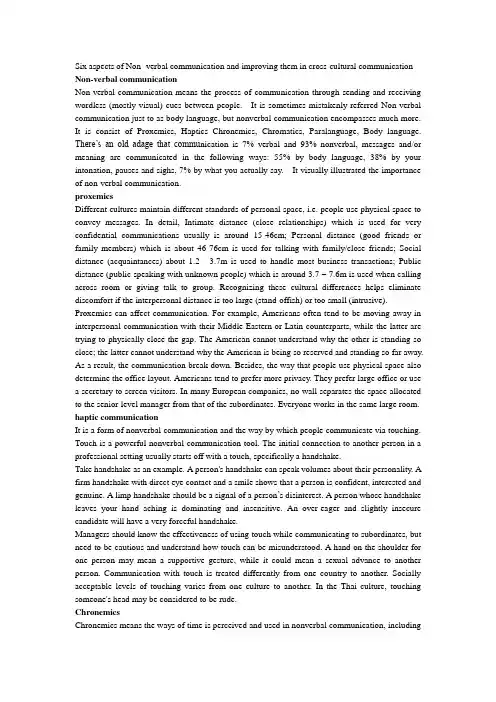
Six aspects of Non- verbal communication and improving them in cross-cultural communication Non-verbal communicationNon-verbal communication means the process of communication through sending and receiving wordless (mostly visual) cues between people. It is sometimes mistakenly referred Non-verbal communication just to as body language, but nonverbal communication encompasses much more. It is consist of Proxemics, Haptics Chronemics, Chromatics, Paralanguage, Body language. There’s an old adage that commu nication is 7% verbal and 93% nonverbal, messages and/or meaning are communicated in the following ways: 55% by body language, 38% by your intonation, pauses and sighs, 7% by what you actually say. It visually illustrated the importance of non-verbal communication.proxemicsDifferent cultures maintain different standards of personal space, i.e. people use physical space to convey messages. In detail, Intimate distance (close relationships) which is used for very confidential communications usually is around 15-46cm; Personal distance (good friends or family members) which is about 46-76cm is used for talking with family/close friends; Social distance (acquaintances) about 1.2 - 3.7m is used to handle most business transactions; Public distance (public speaking with unknown people) which is around 3.7 – 7.6m is used when calling across room or giving talk to group. Recognizing these cultural differences helps eliminate discomfort if the interpersonal distance is too large (stand-offish) or too small (intrusive). Proxemics can affect communication. For example, Americans often tend to be moving away in interpersonal communication with their Middle Eastern or Latin counterparts, while the latter are trying to physically close the gap. The American cannot understand why the other is standing so close; the latter cannot understand why the American is being so reserved and standing so far away. As a result, the communication break down. Besides, the way that people use physical space also determine the office layout. Americans tend to prefer more privacy. They prefer large office or use a secretary to screen visitors. In many European companies, no wall separates the space allocated to the senior-level manager from that of the subordinates. Everyone works in the same large room. haptic communicationIt is a form of nonverbal communication and the way by which people communicate via touching. Touch is a powerful nonverbal communication tool. The initial connection to another person in a professional setting usually starts off with a touch, specifically a handshake.Take handshake as an example. A person's handshake can speak volumes about their personality. A firm handshake with direct eye contact and a smile shows that a person is confident, interested and genuine. A limp handshake should be a signal of a person’s disinterest. A person whose handshake leaves your hand aching is dominating and insensitive. An over-eager and slightly insecure candidate will have a very forceful handshake.Managers should know the effectiveness of using touch while communicating to subordinates, but need to be cautious and understand how touch can be misunderstood. A hand on the shoulder for one person may mean a supportive gesture, while it could mean a sexual advance to another person. Communication with touch is treated differently from one country to another. Socially acceptable levels of touching varies from one culture to another. In the Thai culture, touching someone's head may be considered to be rude.ChronemicsChronemics means the ways of time is perceived and used in nonverbal communication, includingpunctuality, willingness to wait and interactions. The use of time can affect speed of speech, movements and how long people are willing to listen. It include Monochronic and polychronic time schedule.In monochronic time schedule, Time is linear, straight line and heading towards progress or degeneration. Doing one thing at a time and time is segmented into precise, small units and is scheduled, arranged and managed. Besides, Time is tangible and a precious resource not to be wasted or taken lightly. In addition, the schedule is sacred. People use time to structure daily lives and events and strictly follow schedules. It is oriented to task by getting things done and moving to the next. In polychronic time schedule, Many things occur at the same time. It often arranges schedule multiple appointments simultaneously and keep on schedule is an impossibility. Besides, it stresses deeply steeped in relationships rather than in tasks. Schedules are not as important as dealing with others. Relationship is what really matters.Interactions between the two cultures can be problematic. Monochronic businessmen cannot understand why the person they are meeting is always interrupted by phone calls and people stopping by. Polychronic businessmen cannot understand why tasks are isolated from the organization as a whole and measured by output in time instead of part of the overall organizational goal.chromaticsChromatics refers to color used to communicate messages.Every society uses chromatics, but in different ways. Colors that mean one thing in the US may mean something different in Asia. For example, in west, red stands for love or aggression, but it means happiness or good luck in China. In Korea, the color red is used to write the names of the dead, extremely unlucky to write the names of living people in red.paralanguageParalanguage is how you say what you’re saying including pitch, volume and intonation of speech and manner of speaking. People can convey very different meaning with the same words and different intonation. Listeners will perceive a variety of subconscious clues in vocal qualities. Knowing how emotional content is conveyed and perceived via paralanguage can help anyone improve their communication skills, as nonverbal communication is even more important to getting a message across than the words used.body languageBody language means the process of communicating what you are feeling or thinking by the way you place and move your body rather than by words including posture, gesture, facial expression and eye contact. Body language often cause mistrust among cross-cultural parties. Take gesture as an example. Cross-cultural misunderstandings directly related to gestures may cause embarrassment, which is absolutely to be avoided at work. People do business only with people they know, like and trust. It’s the reason why elegant clothes, excellent references and proposals are often useless in the face of an inappropriate gesture, albeit gentle and innocent. Improving body language is essential in cross-communication. In order to stimulate good things, smile is a good choice; shaking hands so as to connect instantly with someone.。
